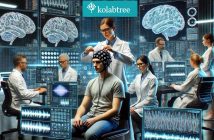The education system around the world has taken several strides where students and schools are trying to move away from the previous system of memorizing the facts and gulping them out during examinations. This has led to several new interactive methods of teaching, including ‘brain-based learning methods’, use of videos, interactive quizzes, problem solving, and activity based learning techniques. Thousands of studies have focused on the neural pathways of learning and memory but in this article we will try to understand how such innovative teaching methods can improve learning.
Anita was unpacking her school bag. Today she was taught plant and animal classification. Her homework is to observe animals around her and classify them as vertebrates and invertebrates. She also has to go to the school’s botanical garden and collect plants based on their habitat (land, water, or scarce water). She then has to list what features are visibly different in their appearances.

Neurogenesis or birth of new neurons contributes to only ~ 0.004% of the total neuron population. Thus, most of the ‘brain changes’ during learning have been attributed to changes in the number and strength of these connections or synapses between the neurons. Neurons have long thin projections called axons and dendrites through which they talk to other neurons. Axons release chemicals or neurotransmitters which then bind to the receptors on the surface of the receiving dendrite. As soon as the neurotransmitter binds to the receptors on the receiving dendrite of another neuron, it directly or indirectly creates an electrical signal causing it to ‘fire’. These connections between the neurons are ‘plastic’, i.e. the more a connection is activated, the stronger it gets. For e.g. the neuron receiving the signal may become more receptive to the signal (more neurotransmitters may be added to the receiving dendrite by the neuron sending the signal). This is also referred to as ‘synaptic plasticity’. If two neurons are activated together for long periods of time, it forms the basis of long-term memory. This is has led to coinage of the famous adage by Carla Shatz, ‘neurons that fire together, wire together’. Studies have shown that blocking synaptic plasticity can hamper behavioral learning, indicating its crucial role.
Now going back to our initial point of discussion, how different teaching strategies improve this process of learning and memory? We will take three examples of innovative teaching methods: actively-engaging homework, concept maps, and problem-based learning to understand their possible effects on brain.
Frequent and active homework
Learning phase is usually thought to be when we are studying, while tests and homework are simply passive regurgitation of the facts already learned. However, several studies have shown that the process of retrieving information (as done during tests or homework) is critical for learning. Students who retrieved information several times performed significantly better than students who retrieved information only once in the final test conducted one week later. Repeated study with no retrieval had no significant improvement on the student’s performance. Also, time intervals between retrievals also have a significant influence. If the time interval is too small (~ 1min) then there are no significant benefits whereas, longer time intervals (~ 6 min) had a greater effect on retention.
This raises another question, does repeated testing merely improve the memory where the students simply provide a fixed answer to a particular question so does it actually improve learning or ‘transfer of knowledge’. This was also tested, where after repeated studying or repeated testing the children were subjected to a final test which posed questions which could only be answered by applying concepts from the studies passages. Even in this case, the students with repeated tests fared better, indicating better retention and learning.
What effect can frequent and active homework have on our brains? One of the key factors for learning and memory are attention and motivation. Situations of reward and novelty are associated with release of neurotransmitters, dopamine and acetylcholine. One possibility is that frequent retrieval of information and active homework involves more attention leading to release of Dopamine and Ach, which may enhance synaptic plasticity, forming the basis of improved learning.

Concept Maps
Anita studied immune system and digestive system of humans today. Her next homework involved drawing connections between components of digestive system which could influence immune system and vice versa.
One of the critical problems which many children face is that they view each subject and concept in isolation. This is a math problem, this is a physics problem…They have no idea how trigonometry they study in classrooms can deal with real-life situations.
Concept maps involve studying and encoding relationships between different concepts students study in school. Studies performed on children ranging from grade 4 to secondary level have shown increased knowledge retention in tests performed after concept maps were used.
How can concept maps improve retention of knowledge? For this, we would have to go back to how we retrieve memories. Memories and information are stored as synaptic networks. When few nodes on a network are activated, the whole network is activated and the information is retrieved. Thus, a network which has many nodes spanning different concepts and memories has a higher chance of being retrieved faster and more easily. This principle could explain why a student who had spent time connecting different concepts could retrieve them significantly better in a test.
Problem-based learning
Today at school, Sneha was taught photosynthesis – the process by which chlorophyll, the green pigment in leaves, absorbs energy from light. She was made to read-out the process from the book and write the equations for photosynthesis several times.
Anita, who was in a different school also learnt about the process of photosynthesis. As an assignment her teacher asked her to go to the botanical garden, observe, and record plants with leaf colours other than green. Then, she had to write a report on how plants with other colours survived. Was it possible for those plants to produce their own food if they didn’t have the green pigment chlorophyll?
There is a clear difference in the way Sneha and Anita were taught photosynthesis. Several studies have shown that problem based learning leads to improved retention and conceptual understanding of the text. One of the possibilities is that problem-based learning could improve attention and motivation, factors which have been shown to increase dopamine secretion, in children. Secretion of these neurotransmitters may forge new synaptic connections and thus, improve a child’s retention and learning.
Thus, innovative teaching methods can improve the neurobiological make-up of children leading to improved understanding of concepts and retention compared to simply reading and writing the passages from books – passive modes of teaching.
However, a pitfall is several educational systems are employing ‘brain-based’ teaching methods which have no scientific basis and thus, are ineffective teaching tools apart from promoting pseudoscience. In the end, let us look at few of the myths associated with neuroscience and education.
Neuroscience and education – myths and truth
One of the most popular ‘brain myth’ is the ‘left brain-right brain theory’, which suggests that in every individual either right or left brain side of the brain is dominant. Some educationists even encourage determining whether a student is right or left brain and attempt different teaching strategies based on the results. Although, certain functions of the body may be attributed to the left or right side of the brain but there has been no evidence so far to suggest that different sides may dominate in different individuals. The myth continues further suggesting left brain people are more logical and analytical, while right brained people are intuitive and objective. Thus, a child being labeled as a left-brained or right-brained may feel that they are innately incapable of creative or logical skills. The separation of logic and creativity is also unscientific as logical problems often involve creative solutions.
Studies have shown that almost 50% of educators from different countries, including UK, Netherlands, Greece, China, and Turkey believe in the neuromyth that we mostly use only 10% of our brain. Neuromyths in education usually spread when educators and neuroscientists do not communicate. Many of the explanations or arguments against these myths are present in journals which are difficult to access or in a language which is difficult to understand by the non-specialists. Thus, there is a need to open avenues of communication between teachers and scientists to clear these misconceptions.
What does the future hold?
Although several studies have tested how brain stores and retrieves memories during learning, there are still many things we don’t know. What is the exact nature of the link between learning and molecular, cellular signatures in the brain? How do we organize knowledge or information in our brain, and the basis of metacognition- the process of understanding our own thought process?
Rather than employing strategies which promote pseudo-science and neuromyths, an understanding of current theories and myths, and better communication between scientists and educators may help in development of more effective teaching strategies and convert the lab notes to classroom teaching.
——————-
Need to consult a freelance scientist or researcher? Get in touch with experts from MIT, Cambridge, Harvard, and more on Kolabtree.







